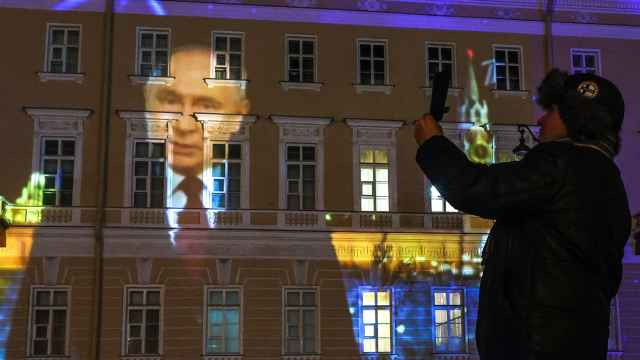The Central Bank is unlikely to follow other emerging markets and raise interest rates to put a floor under its sliding currency — at least not for now, analysts say.
But they warn that if the ruble's depreciation goes on, leading either to a panic among ordinary people or to much higher inflation, the policy calculus could yet change.
The Central Bank spent billions of dollars intervening on the market to support the ruble last week. Despite this, the ruble slid steadily, and the regulator was forced to repeatedly adjust downwards the target trading corridor in which, under the ruble's managed float, the currency is supposed to trade. On Monday, the Central Bank shifted the corridor's boundaries by another five kopecks, following a further round of interventions.
Last week, the Turkish and South African central banks both raised rates — in Turkey's case dramatically — fueling investor speculation about whether Russia might also be forced to take similar measures.
The ruble has lost 5 percent this year, the biggest plunge since the 2008 to 2009 financial crisis, testing the Central Bank's resolve to complete a shift to inflation targeting, an approach that makes interest rates its most important tool.
Higher rates, making it more rewarding to hold money in ruble accounts or bonds, could be one way to persuade people to hold on to the Russian currency.
Nevertheless, economists polled last week predict that Russia would hold its key policy rate at 5.5 percent until the third quarter — and then cut, not hike.
"At the moment it is highly unlikely that they will raise interest rates," said Liza Yermolenko, emerging markets economist at Capital Economics in London.
"If the ruble falls a lot further, if there is a further escalation in the emerging-market crisis, or if the oil price drops, this is a possibility. But it will take a much deeper fall in the ruble before the Central Bank will do that."
Russia cannot afford to ignore the ruble's slide entirely. In the worst case, it could provoke a panic among savers, leading to a run on ruble deposits similar to the financial crises in 1998 and 2008.
The share of forex bank deposits held by households and companies nearly doubled to 43.5 percent in the months before February 2009. That panic lagged behind, and exacerbated, an initial slide in the ruble.
Forex deposits accounted for 26 percent last November, the latest figures show, reflecting complacency among savers before the currency rout began to spread across emerging markets.
"The ruble weakening is now almost exclusively driven by a panic among households," said Alexander Morozov, chief Russia economist at HSBC. "Going forward, we should expect more and more readiness of the Central Bank to somehow stop this panic. That may include a temporary hike in policy rates."
Analysts note that the scale of the latest turmoil is still minor compared to past ruble trouble, suggesting that drastic measures are not yet called for.
So far this year, the Central Bank has expended less than $10 billion in foreign reserves, out of almost $500 billion available. It went through $200 billion in a matter of weeks at the height of the 2008 to 2009 crisis.
Higher interest rates in Russia would, moreover, be highly unpalatable both on economic and political grounds. The Central Bank has been under political pressure for more than a year to cut interest rates and boost an economy whose growth has slowed to a crawl.
According to government estimates, the economy grew by just 1.3 percent in 2013, the lowest since the 2009 slump. President Vladimir Putin has made clear that he sees a reduction in borrowing costs as a key goal — and he has tasked Nabiullina with finding ways to do it.
"People have been urging the Central Bank to cut interest rates, so it would be too much of a U-turn for it to start hiking," said Capital Economics' Yermolenko.
Nevertheless, a sliding ruble also threatens to complicate another key goal — lower inflation — which the Central Bank sees as a bigger priority than kick-starting the sluggish economy.
"One scenario is that the Central Bank might hike in response to strong pass-through from the weaker ruble as import prices rise," Morgan Stanley economists said in a research note,
The Central Bank aims to cut inflation to 5 percent by the end of this year — down from 6.5 percent last month, which was an embarrassing half a percentage point above its 2013 target.
HSBC's Morozov calculates that every one percent fall in the ruble feeds through into an increase of the headline inflation rate of about one decimal point.
A Message from The Moscow Times:
Dear readers,
We are facing unprecedented challenges. Russia's Prosecutor General's Office has designated The Moscow Times as an "undesirable" organization, criminalizing our work and putting our staff at risk of prosecution. This follows our earlier unjust labeling as a "foreign agent."
These actions are direct attempts to silence independent journalism in Russia. The authorities claim our work "discredits the decisions of the Russian leadership." We see things differently: we strive to provide accurate, unbiased reporting on Russia.
We, the journalists of The Moscow Times, refuse to be silenced. But to continue our work, we need your help.
Your support, no matter how small, makes a world of difference. If you can, please support us monthly starting from just $2. It's quick to set up, and every contribution makes a significant impact.
By supporting The Moscow Times, you're defending open, independent journalism in the face of repression. Thank you for standing with us.
Remind me later.





